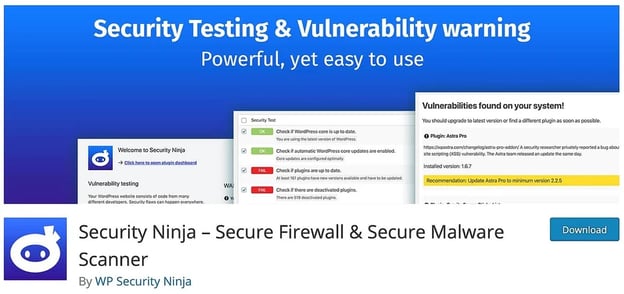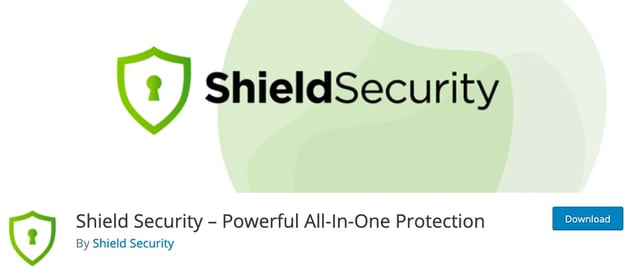Sucuri and Wordfence: The Basics
Sucuri and Wordfence are both WordPress security plugins you can download and install on your site to detect and defend against potential threats. They’re considered the top two plugins in the WordPress security space — as a result, they offer similar functions to help protect your site.
The differences are in the details. For example, while Sucuri offers a variety of post-attack actions to help reduce the risk of future compromise, Wordfence provides real-time monitoring of users to help pinpoint attacks before they begin. In effect, these are two sides of the same coin — which works best for your site depends on current needs around data protection, attack detection, and remediation.
For each plugin, we’ll compare and contrast four key areas: Ease of use, firewall defense, active alerts, and pricing.
Exploring Wordfence
Let’s start with an exploration of Wordfence. According to the plugin’s official site, the plugin has been downloaded more than two hundred million times and regularly blocks nearly nine billion attacks per month.
Wordfence is all about WordPress security — the plugin is designed specifically for WordPress sites and includes both an endpoint firewall and malware scanner built to defend WordPress deployments. It also features a real-time Threat Defense Feed that updates firewall functions with the latest malware data.
Ease of Use
Getting started with Wordfence is straightforward. Download the plugin and install it, then agree to the terms of service, provide your email address for security notifications, and you’re good to go. Wordfence also includes a setup wizard to help guide you through the process and get everything up and running.
The biggest potential drawback? A cluttered and somewhat unintuitive interface. While all the data and features you need are there, it’s not always easy to find.
Firewall Defense
As noted above, Wordfence includes a dedicated WordPress firewall that’s regularly updated to help monitor your site for potential attacks and provide immediate notifications. When it’s first activated the firewall enters “learning mode,” which lets it understand how users access your site and helps pinpoint potentially malicious behavior —meaning it can actively improve defense the longer it runs.
The challenge? Initially, the firewall is only active when your WordPress site loads. You can change it to continuous monitoring via the “Extended Mode” but this requires manual setup. It’s also worth noting the Wordfence firewall is endpoint-based, meaning it can only block traffic once it has already reached your site.
Active Alerts
Alerts in Wordfence are straightforward. First, they’re highlighted next to the plugin name itself in your admin dashboard. When you click through to the plugin, you’ll get a list of alerts organized by severity. Simply click on a notification to learn more about its potential risk and how to fix it. You’ll also get notifications of critical events via email, and you can set the severity of an event that will trigger the email.
Pricing
Wordfence offers different pricing tiers depending on the number of licenses you buy and the length of coverage you choose.
A single license is $99 per year, while buying 2-4 saves you 10%, 5-9 saves 15%, 10-14 saves 20%, and 15 or more comes with a 25% discount. You can also save 10% off your initial purchase if you buy two years of coverage up-front, or 20% if you purchase three years.
Evaluating Sucuri
Sucuri, meanwhile, offers a WordPress security plugin as part of its larger suite of security services. It includes website hardening features to frustrate attackers, active malware scanning to detect threats, and core file integrity checks to ensure your site security is up to snuff.
Ease of Use
Sucuri is also easy to use. Download and install the plugin and it automatically performs a quick scan for any active security threats. The interface is streamlined and simple with a minimum of extra windows or pop-ups.
Firewall Defense
Sucuri uses a cloud-based website application firewall (WAF) which means it’s continually active and requires no maintenance by site owners. It’s also capable of detecting and intercepting traffic before it reaches your site to help stop the spread of malware and ransomware.
It does, however, require you to modify your domain name DNS settings to ensure all traffic is routed through Sucuri’s servers.
Active Alerts
Sucuri displays the current status of your WordPress files in the upper right-hand corner of the plugin page. The middle of the page contains details about audit logs, iFrames, links, and scripts, and under the Settings tab you can modify the number of alerts you receive per hour and the events that trigger these alerts — such as the number of failed logins per hour.
Pricing
Sucuri offers three tiers of pricing: Basic, Pro and Business. Basic plans are $199.99 per year, Pro plans are $299.99 per year and Business plans are $499 per year.
Along with increased frequency of security scans, premium plans also come with quicker malware removal SLAs. While the Basic plan has a malware removal SLA time of 30 hours, the Business plan offers resolution in just 6 hours.
Alternative WordPress Security Plugins
Don’t like either of the protective plugins we’ve described above? Other WordPress security options include:
1. Defender
Price: Free, with paid plans available

Defender has been downloaded one million times and offers a firewall with IP blocking, malware scans, and brute-force login protection — all for free. You can also upgrade to Defender Pro for $49 per month to access more in-depth support and reporting options.
2. All in One WP Security and Firewall
Price: Free

This plugin is free, versatile, and popular. It provides malware and vulnerability scanning along with database backups and firewall protection.
The caveat? If you want more advanced features, you’ll need to activate them by editing your .htaccess file.
3. Jetpack
Price: Free, with paid plans available

Jetpack is an all-inclusive security solution that comes with spam and malware blocking along with activity logs and site stat reporting — all for free. Upgrading to Jetpack Premium, meanwhile, gets you daily scans and the ability to back up your site in real-time for easy restoration.
4. Security Ninja
Price: Free, with paid plans available

The Security Ninja plugin includes more than 50 security checks to help pinpoint potential problems on your WordPress site. Upgrade to Security Ninja Pro for $39.99 per month and these checks — along with fixes — are handled automatically.
5. Shield Security
Price: Free with paid plans available

The free version of Shield Security includes an application-layer firewall and automatic blocking of malicious actions and bots. Pay for ShieldPro, meanwhile, and you get access to dedicated technical support for increased site security.
Looking for even more plugin options? Check out our list of great WordPress security plugins to help protect your site.
And The Winner Is…?
It depends.
Both Sucuri and Wordfence offer a host of great security services and solutions, but which one is right for you depends on your needs.
For example, if a cloud-based firewall that stops malicious traffic before it hits your site is your biggest priority, Sucuri is your security plugin of choice. If you need a cost-effective security platform with robust alerts and notifications, meanwhile, Wordfence may be the better bet.
No matter which plugin you choose — Wordfence, Sucuri, or another defensive option — the right solution is the one that provides peace of mind without breaking the bank.
WordPress Website




![How to become a WordPress developer [+ tips from WCEU speaker Paul Bearne]](https://53.fs1.hubspotusercontent-na1.net/hubfs/53/59_How%20to%20Become%20a%20WordPress%20Developer.png)








